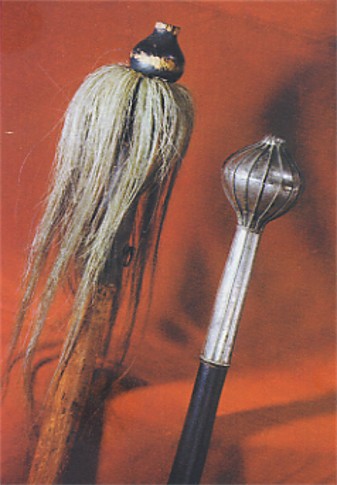Hetman
Hetman (from the German Hauptmann and the Polish hetman: ‘leader’). In the Polish Kingdom in the 16th century, local military commanders and administrators were known as hetmans. The title was also used for the supreme military commander both in Poland and in the Grand Duchy of Lithuania (see Grand hetman). At the end of the 16th century the commander of the Cossacks, originally known as the elder (starshyi), also became known as the hetman. The first Cossack hetmans included Kryshtof Kosynsky, Severyn Nalyvaiko, Petro Konashevych-Sahaidachny, and Taras Fedorovych.
From 1648 the hetman was the head of the Cossack state (see Hetman state). In this capacity he had broad powers as the supreme commander of the Cossack army; the chief administrator and financial officer, presiding over the state's highest administrative body, the General Officer Staff; the top legislator; and from the end of the 17th century, the supreme judge as well. The first hetman who was also head of the state was Bohdan Khmelnytsky. The hetman issued administrative decrees, called Hetman manifestos, which were binding on the whole population. His powers extended to some degree even to church affairs: he confirmed the appointment of church hierarchs and endowed bishoprics, monasteries, and sometimes churches with lands. He also appointed many officials of the state and granted land for service. The hetman represented the state in its external relations, receiving and sending out envoys and concluding treaties. With the partition of Ukrainian territories between Poland and Muscovy in the 1660s there arose competing hetmans in Right-Bank Ukraine and Left-Bank Ukraine and a prolonged period of civil war began. Right-Bank hetmans soon lost their political power, becoming simply commanders of Cossack military formations under Polish or Ottoman control.
Hetmans were elected by the General Military Council for an unspecified term: in principle for life, but in practice for ‘as long as it pleases the host.’ Since their authority was not constitutionally defined, it varied greatly and depended on the personalities of the individuals involved. In general, their authority overlapped or was limited by the powers of other state institutions, such as the General Military Council and the Council of Officers, which included senior officers and colonels of the Cossack regiments. From the end of the 17th century the tsar of Muscovy, through his representatives at the military councils, greatly influenced the election of hetmans. In the 18th century the hetman's powers were reduced and he became more dependent on the tsar. In particular, the tsarist government deprived hetmans of the right to conduct their own foreign relations and steadily increased its control over Ukraine's internal administration. In Left-Bank Ukraine each new hetman swore an oath of allegiance to the tsar and concluded a new agreement with the tsarist government outlining his rights and responsibilities (see Hetman articles).
The more important hetmans of all Ukraine were Bohdan Khmelnytsky (1648–57), Ivan Vyhovsky (1657–9), and Yurii Khmelnytsky (1659–63). Renowned Right-Bank hetmans included Pavlo Teteria (1663–5), Petro Doroshenko (1665–76), and Yurii Khmelnytsky (1667–81 and 1685), while Left-Bank hetmans included Ivan Briukhovetsky (1663–8), Demian Mnohohrishny (1669–72), Ivan Samoilovych (1672–87), Ivan Mazepa (1687–1709), Ivan Skoropadsky (1709–22), Pavlo Polubotok (acting hetman 1722–4), Danylo Apostol (1727–34), and Kyrylo Rozumovsky (1750–64). After several earlier attempts, the office of hetman was finally abolished by Catherine II in 1764, and its responsibilities were assumed by the Little Russian Collegium. Hetman rule displayed both monarchic and republican tendencies, but the former were dominant, particularly under B. Khmelnytsky, who hoped to establish a hereditary hetmancy, I. Samoilovych, and I. Mazepa. The hetman's insignia included the bulava, standard, flag, and seal. An officer who carried out temporarily the duties of a hetman was known as the acting hetman. Many hetmans gained renown as patrons of Ukrainian culture by establishing monasteries and schools.
Pavlo Skoropadsky, the head of the Ukrainian state from April to December 1918, revived the title of hetman. (See Hetman government.)
BIBLIOGRAPHY
Diadychenko, V. Narysy suspil’no-politychnoho ustroiu Livoberezhnoï Ukraïny kintsia XVII–pochatku XVIII st. (Kyiv 1959)
Okinshevych, L. Ukrainian Society and Government, 1648–1781 (Munich 1978)
Lev Okinshevych
[This article originally appeared in the Encyclopedia of Ukraine, vol. 2 (1989).]


.jpg)
.jpg)